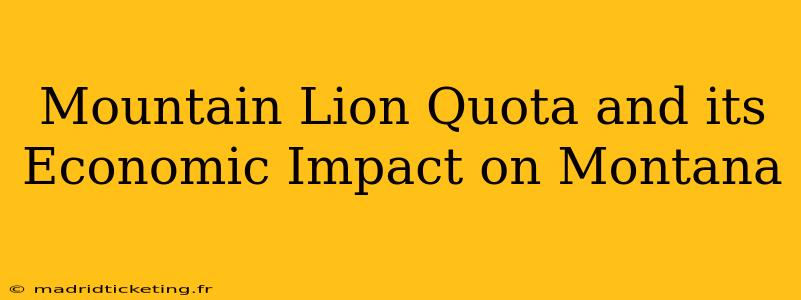Montana's mountain lion population, a vital part of the state's ecosystem, is a subject of ongoing debate, particularly concerning hunting quotas and their economic effects. Understanding the complexities of this issue requires examining both the ecological role of mountain lions and the significant economic implications of lion hunting and conservation efforts. This exploration delves into the multifaceted relationship between mountain lion quotas, tourism, hunting industries, and the overall economic health of Montana.
What are the current mountain lion hunting regulations in Montana?
Montana's Fish, Wildlife & Parks (FWP) department manages mountain lion hunting through a system of permits and quotas that vary by hunting district. These regulations are designed to maintain a healthy lion population while considering the needs of other wildlife and human safety. The specific regulations, including hunting seasons, license requirements, and bag limits (number of lions allowed to be harvested), change annually and are available on the FWP website. Understanding these regulations is crucial for hunters and anyone interested in the management of mountain lion populations in the state. These regulations are frequently adjusted based on population surveys, public comment, and the overall health of the ecosystem.
How do mountain lion hunting quotas impact the state's economy?
The economic impact of mountain lion hunting in Montana is two-fold. On one hand, it generates revenue through license sales, hunting fees, and related expenditures by hunters. This includes money spent on gear, lodging, guides, and other services within the state. This influx of funds benefits local economies, particularly in rural communities near hunting areas. On the other hand, the potential for negative impacts exists. If lion populations decline significantly due to hunting, this could negatively affect wildlife viewing tourism, another significant economic contributor to the state. A healthy lion population attracts wildlife enthusiasts, photographers, and other tourists, generating revenue for hotels, restaurants, and tour operators. Striking a balance between hunting and conservation is vital for maximizing the overall economic benefit.
Does the decline in mountain lion population affect tourism in Montana?
The relationship between mountain lion populations and tourism in Montana is complex. While a robust lion population can attract wildlife enthusiasts and generate revenue from wildlife viewing tourism, an over-hunted population could have the opposite effect. Many tourists visit Montana hoping to see a variety of wildlife, and the absence of mountain lions could deter them. Conversely, a thriving lion population contributes to a balanced ecosystem, attracting other wildlife that tourists also enjoy seeing. FWP continually monitors both hunting impacts and tourism data to inform their management decisions. Finding the right balance is essential for preserving Montana's natural beauty and supporting its tourism industry.
How do other wildlife populations in Montana relate to mountain lion population control?
Mountain lions are apex predators, meaning they play a crucial role in regulating populations of other animals. Managing lion populations, therefore, impacts the populations of their prey, such as deer and elk. An increase in lion numbers could lead to a decline in deer and elk populations, affecting hunters targeting those species and potentially impacting hunting revenue. Conversely, a drastic decrease in lion numbers might lead to an overabundance of deer and elk, causing overgrazing and habitat degradation. FWP considers these interdependencies when setting hunting quotas, aiming for a balanced ecosystem that supports multiple wildlife species and recreational opportunities.
What are the long-term economic effects of sustainable mountain lion management?
Sustainable mountain lion management strategies, which consider both ecological and economic factors, can contribute to long-term economic stability in Montana. By carefully managing hunting quotas and monitoring both lion populations and their prey, the state can ensure that both hunting and wildlife viewing tourism continue to thrive. This approach protects biodiversity, maintains healthy ecosystems, and fosters a sustainable economic model based on conservation and responsible resource management. This contrasts with short-sighted practices that prioritize immediate economic gains at the expense of long-term ecological health.
This article aims to provide an objective overview of the complex issue of mountain lion quotas and their economic impact on Montana. The information presented is based on publicly available data and research and should not be considered definitive policy advice. For the most up-to-date information on regulations and management strategies, please consult the Montana Fish, Wildlife & Parks website.

